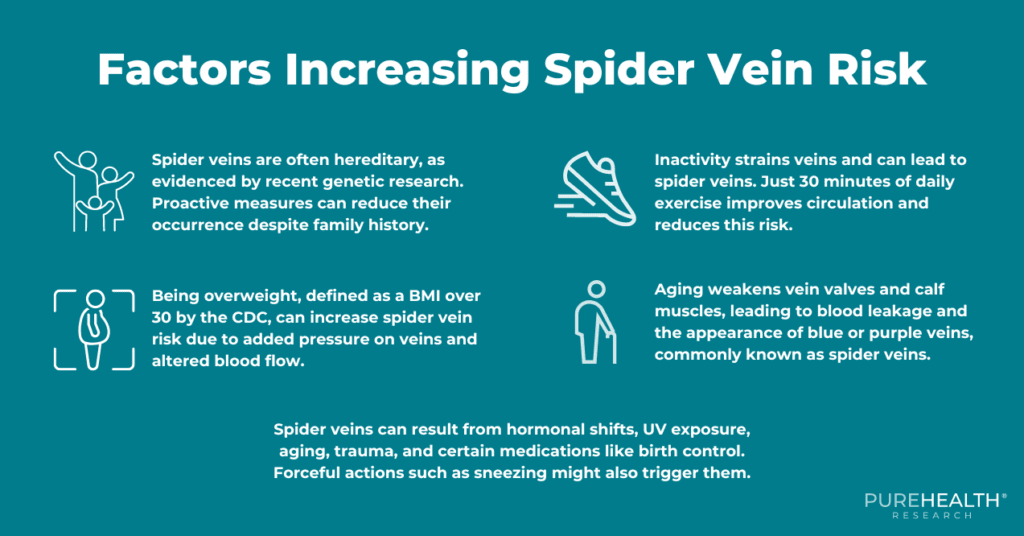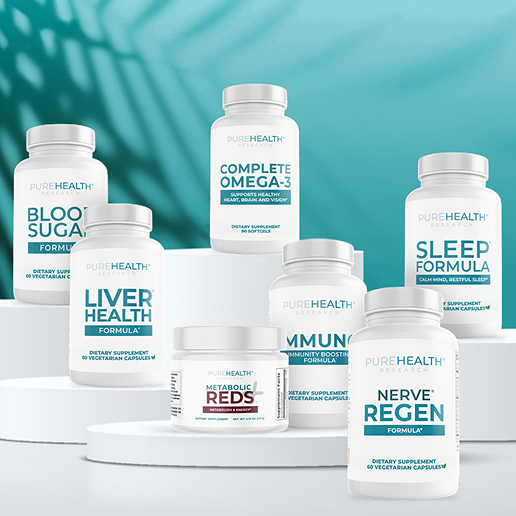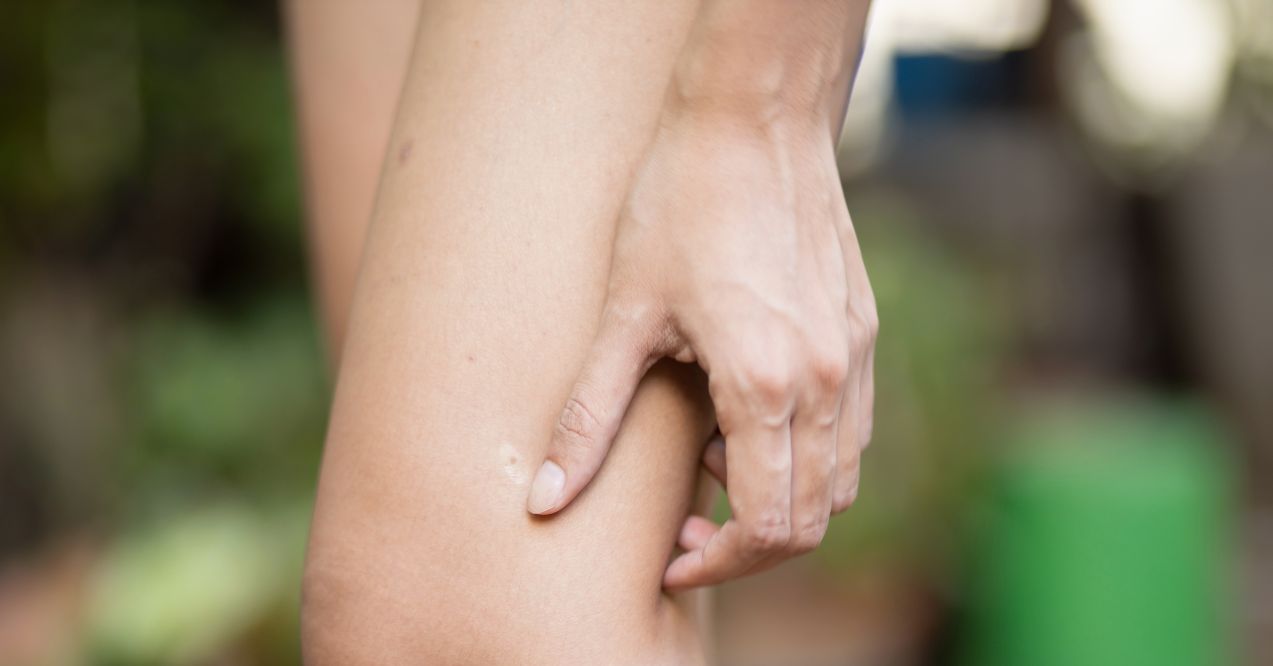Are Spider Veins Genetic? Understanding the Factors
Are spider veins genetic? Uncover the main risk factors for this condition. Explore prevention and treatment options to keep this cosmetic nuisance at bay.


Are spider veins genetic? If you’ve noticed small, visible capillaries on your legs, hands, or face, you may be wondering if they were passed down from your parents or if you could pass them on to your children.
Scientifically known as telangiectasias, spider veins are damaged blood vessels that appear just beneath the skin. Their web-like appearance gives them their name, and while they are usually harmless, they can sometimes indicate an underlying vascular condition.
If these reddish, blue, or purple veins make you feel self-conscious, you’re not alone. In this article, we’ll explore whether spider veins are genetic, what causes them, and what treatment options are available to help manage or reduce their appearance. Keep reading to find out more!
Are Spider Veins Genetic? The Truth About Inheritance
Spider veins are small, dilated blood vessels that appear just beneath the skin’s surface, often taking on a web-like or branching pattern. While they are typically harmless, their appearance can be a cosmetic concern for many individuals.
The Genetic Link
If you have noticed spider veins forming on your legs, hands, or face, you may be wondering if they were passed down from your family. Research suggests that genetics play a significant role in their development. If your parents or close relatives have spider veins, you are more likely to develop them as well. Weak vein walls and poor circulation, both of which can contribute to spider veins, may be inherited traits that make some individuals more susceptible than others.
Other Contributing Factors
While heredity is a strong predictor, it is not the only cause of spider veins. Lifestyle and environmental factors can also increase your risk. Prolonged standing or sitting, hormonal fluctuations (such as those during pregnancy or menopause), excessive sun exposure, and aging can all contribute to the weakening of blood vessels. Additionally, obesity and lack of physical activity can put extra pressure on veins, further increasing the likelihood of developing spider veins.
Prevention and Management
If you have a family history of spider veins, taking proactive steps can help delay or minimize their appearance. Regular exercise, maintaining a healthy weight, elevating your legs when resting, and wearing compression stockings can all support healthy circulation. Additionally, protecting your skin from excessive sun exposure and avoiding long periods of standing or sitting can help reduce strain on your veins.
Understanding Spider Veins
So you have spider veins, and want to get rid of them? Now what? Before you can take action against them, you need to understand what they are and how you got them. Spider veins tend to appear when the tiny blood vessels that sit under your skin become weak and expand. You’re at a higher risk of waking up one day with dark, web-like vein marks on your skin if you have any or all of the following risk factors:
- You’re pregnant
- You smoke — or used to, even if you quit a while back
- Your body mass index (BMI) is over 30
- You are on hormonal birth control
- You remain sitting or standing for long periods
- You spend too much time under the sun without proper protection
- A close family member has varicose veins or spider veins
You might be confused about the difference between spider veins vs varicose veins. How do you tell them apart? Well, firstly, as we mentioned above, spider veins are damaged tiny blood vessels that appear just under your skin — whether capillaries or venules. On the other hand, varicose veins refer to damaged large blood vessels, particularly those that carry deoxygenated blood. Secondly, spider veins do not normally cause any harm to your health and are usually symptomless. In contrast, varicose veins engorge with blood, can twist and bulge out of your skin, and may cause you to feel discomfort and pain.
Even though spider veins are not a significant cause of concern, focusing on the health of your veins by taking supplements and nutrient-rich products is still strongly advised. This is because spider veins may sometimes be an early warning sign of other vein conditions, such as chronic venous insufficiency.
Factors That Amplify Your Chances of Getting Spider Veins
One peculiar thing about spider veins is that they are actually quite common, especially in women. So, apparently, you’re not the only one struggling to hide the visible veins at work or school. In fact, according to the Chicago Vein Institute, about 50% of women develop spider veins at some point during their lifetime. After age 80, spider veins become more common and hard to miss in both males and females.
Are there factors that make you more prone to spider veins? Absolutely. Here is a list of aspects you need to keep an eye on to understand your predisposition to experience this cosmetic nuisance:

1. Genetic Lottery
Have you noticed spider veins on your mom, aunt, or grandmother and wondered if you might develop them too? It’s natural to wonder “are spider veins genetic?”. While research is still ongoing, many experts believe heredity plays a significant role in their development. In most cases, a family history of spider veins can increase the likelihood of getting them, though lifestyle factors also contribute to their appearance. According to a Phlebology: The Journal of Venous Disease study, scientists believe circumstantial evidence links genetics to varicose veins and other gene disorders.
Research published in 2018 solidified the connection between varicose veins and genetic inheritance. Using genetic information from over 400,000 people in the U.K. Biobank, investigators discovered a significant link between inherited traits, specifically taller stature, and the development of varicose veins. Moreover, the analysis uncovered at least 30 genes present in people with varicose veins.
That said, if the older generations in your family have had spider veins, you may likely experience them too. Rather than feeling alarmed, you can leverage your family history to influence your future outcomes. Strengthening your veins and reducing pro-inflammatory responses through appropriate supplements can help promote smooth, blemish-free, toned skin throughout your life, even if others in your family have spider veins.
2. Being Overweight
When your body accumulates excess fat, resulting in overweight conditions, it adversely affects your health. According to the Centers for Disease Control and Prevention (CDC), anyone with a BMI over 30 is classified as obese. But what is the link between being overweight and spider veins?
Excess weight and fat can contribute to the development of spider veins through increased pressure on veins and nerves and changes in blood flow. Excess body weight places added strain on blood vessels, weakening vein walls and valves and compromising the ability of blood to return to the heart and circulation.
3. Age
As you get older, your body undergoes wear and tear, which causes the valves within your veins to weaken. When blood flows through the weak veins, it leaks back because of the poor valves. As a result, purple or blue veins appear beneath your skin.
Additionally, the calf muscles, which support your leg’s veins, can weaken over time. When this happens, the veins lose their support to pump blood upwards, causing the blood to flow in the opposite direction and generating spider veins.
4. Sedentary Lifestyle
If you live an inactive lifestyle, then you’re not doing your veins any justice. Prolonged periods of sitting or lying down force the veins in your legs to work harder to pump blood back to your heart. Over time, this puts a lot of strain on your circulatory system, causing spider veins to form on your skin.
Fortunately, you can enhance your vein health by engaging in regular physical activity. Just 30 minutes of exercise daily or a brisk jog in the mornings or evenings can make a significant difference. Regular exercise accelerates blood circulation, strengthening vein walls and helping to prevent the formation of spider veins.
5. Other Causes
Studies show that there are various other factors that can lead to the appearance of spider veins. Hormonal changes, specifically an excess of estrogen, can potentially trigger this vascular condition, especially on the face or legs. Additionally, extended exposure to UV rays without appropriate protection can cause blood vessels close to the skin to break, leading to the formation of spider veins. Thinning skin from normal aging or malnourishment can make surface veins and arterioles more apparent. In addition, even the force of an exceptionally hard sneeze or vomiting can burst smaller vessels, causing spider veins.
Injuries or accidents that cause physical trauma can harm the skin and disrupt vein valves, resulting in the appearance of purple veins. Additionally, individuals taking birth control pills, mainly those containing hormones, may be more prone to developing spider veins as hormonal imbalances can stimulate their formation.
Preventing Spider Veins
Spider veins can be a concern for many, especially those with a family history of them. Since genetics can play a role in their development, you might be wondering, are spider veins genetic? While heredity is a factor, lifestyle choices also influence vein health. If you’re looking for natural ways to prevent these vascular issues, a few key practices can make a difference:
- Healthy Lifestyle: Ensuring you lead an active lifestyle and maintain a balanced diet can promote good vascular health.
- Sun Protection: Limiting prolonged exposure to the sun and wearing protective clothing can help reduce the risk of developing spider veins.
- Dietary Supplements: Some supplements, such as VenEase by PureHealth Research, support vascular health to help rejuvenate the skin’s health and smooth appearance. Strategic nutrients in VenEase promote blood vessel contractions and functionality, enhance vein tone, and wall integrity, reduce swelling, leakage, and clot formation, and help restore leg vitality. It’s worth noting that many experts, including Dr. Holly Lucille, ND, endorse this product its effectiveness.
VenEase contains a blend of ingredients aimed at addressing vein health:
- Micronized Diosmin + Hesperidin: Derived from orange peels, these compounds may benefit the symptoms of chronic venous impairment.
- Horse Chestnut Extract: This ingredient reduces swelling and strengthens venous contractions and blood flow back to the heart, significantly improving skin health and the shapely appearance of calves and ankles. Rutin Extract: Helps disrupt the protein that forms clots and reduces leakages in the vein valves.
- Butcher’s Broom Root Extract: Contains compounds that help strengthen vein walls and the muscular valves that return blood to the heart, alleviating swelling and blood pooling.
Before adding any supplement to your regimen, it’s paramount to consult with a healthcare professional. Some products, including VenEase, might not be suitable for everyone, especially pregnant women, children, or those on specific medications.
Seeking Spider Veins Treatment
Disclaimer: The information provided below is not intended as medical advice. Always consult with a healthcare professional before making decisions about treatments or supplements.
VenEase Supplement: For those interested in a natural approach to support vein health, VenEase supplement might be a consideration. While it is formulated to potentially aid vein health, it’s important to note that it’s not a treatment for spider veins or any medical condition.
Medical Treatments for Spider Veins:
1. Laser Therapy
A non-invasive method used by skin experts to target spider veins. Laser treatment heats the veins, and over time, the body’s natural processes might clear away the affected veins. It’s an option for those apprehensive about injections. However, it’s worth noting that larger veins might take up to three months to fade.
2. Sclerotherapy
This minimally invasive procedure involves injecting a solution known as sclerosant into the spider veins, causing them to collapse and gradually fade. Many individuals notice improvements within six weeks of sclerotherapy post-treatment.
It’s crucial to thoroughly research and discuss with a medical professional before deciding on any treatment or supplement. It’s also worth mentioning that many vein-removal treatments result in vein regrowth after some time. After all, blood vessels supply your body with nourishment, immune markers, hormones, and more while removing harmful cellular waste products.
Remember, treating spider veins requires time and patience. Therefore, knowing how to cover spider veins on legs can also be beneficial while waiting for the results to appear. By exploring strategies to conceal spider veins, individuals can feel more confident and comfortable in their appearance while undergoing treatment or awaiting visible improvements.
Final Thoughts
Are spider veins genetic? Well, although research is still ongoing, they most likely are. The good news is that you can start taking care of your vein health today and lower your risk of developing this unpleasant condition.
You can seek cosmetic treatments like laser therapy and sclerotherapy if you don’t mind the hefty price tag. However, if you’re seeking a more budget-friendly option to recover the beauty of your skin, then our VenEase supplement could help. In addition to producing impressive results, this blend is vegan and free of gluten and dairy products. Treat yourself to a powerful, expert-approved supplements for vein health and keep those annoying spider veins at bay.
Sign up for our Healthy Living newsletter!
Advertisement. This site offers health, wellness, fitness and nutritional information and is designed for educational purposes only. You should not rely on this information as a substitute for, nor does it replace, professional medical advice, diagnosis, or treatment. If you have any concerns or questions about your health, you should always consult with a physician or other health-care professional. Do not disregard, avoid or delay obtaining medical or health related advice from your health-care professional because of something you may have read on this site. The use of any information provided on this site is solely at your own risk.











